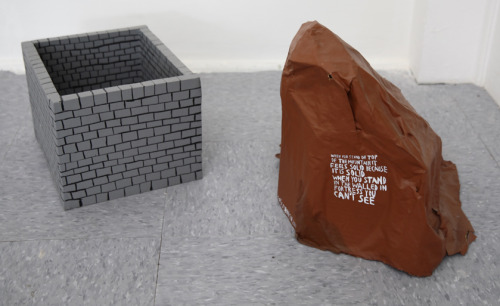Dikeou Superstars: Chris Johanson

Monumental sized works like Momoyo Torimitsu’s Somehow I Don’t Feel Comfortable and Wade Guyton’s The Room Moved The Way Blocked have a bold presence at Dikeou Collection, but there are many small works that still make assertive statements. Chris Johanson’s Mountain/Fortress is one of these pieces. Made out of papier-mâché and wood, viewers must crouch down to the floor to read the text painted on the mountainside. “When you stand on top of the mountain it feels solid because it is solid. When you stand in the walled in fortress you can’t see.” This verbiage is meant to sound empowering and make the viewer feel big and inspired when they stand up after reading it, but the reality is that the words are utterly meaningless and only impress those who naively subscribe to flimsy shreds of wisdom without carrying any kind of resolve of their own. The words are also indicative of the eccentric social climate of Johanson’s childhood, when New Age movements and self-help culture rose to prominence in the late-1960s in the Bay Area of Northern California. This and other influences from growing up like comics, zines, graffiti, punk rock, and skateboarding provided a visual and cultural smorgasbord which Johanson synthesized into his own artistic style. He became synonymous with a group of artists who gained recognition in the early 1990s in San Francisco, known as the Mission School of artists. San Francisco is a very small city geographically speaking (less than 50 square miles), so to pinpoint a specific district as its emerging creative hub seems arbitrary, but the term really applies to the Northern California region as whole and has has done much to bolster the profile of many artists from the area.
Mountain/Fortress was created when Johanson’s career started to hit its stride and was exhibited in Chicago at Vendata (now Kavi Gupta Gallery) in 2001. A simultaneous exhibition at Bodybuilder and Sportsman Gallery, also in Chicago, featured a human-size fortress where people could step in and watch one of his videos. He created a human-scale version of the Mountain for the Hammer Museum in Los Angeles that same year. By creating similar works in two drastically different sizes he demonstrates how scale not only affects space but people’s relationship with the art and thus its inherent meaning and conceptual value. He achieves this through his use of materials, too. The small Mountain at Dikeou Collection is made out of paper and glue and is very fragile, whereas the bigger version of the Fortress exhibited at Sportsman is sturdy and can withstand a lot of physical impact.

Hammer Projects: Chris Johanson. Installation view at the Hammer Museum, Los Angeles. May 1-July 29, 2001. Photo by Joshua White.
Whether small and delicate or large and durable, Johanson creates his art with everyday materials that are common and inexpensive, or things (usually wood) that he has found and repurposed, which is a shared trait amongst other artists from the Mission School. Alicia McCarthy’s aesthetic, for example, is closely aligned with Johanson’s, and she also uses found wood as surfaces for her paintings, which gives a sculptural quality to a traditionally two-dimensional medium. Thomas Campbell creates assemblages that are comprised of fabric, old office supplies, and preserved gourds. In an area currently ruled by billionaire techies, the folksy, scrappy, rough-hewn art by Bay Area creatives is like a breath of fresh air, providing an escape from the overpriced and hyper-digital landscape.
Even though the Mission School label primarily applies to artists who work in painting and sculpture, they still engage with and absorb inspiration from people working in other creative capacities. Johanson himself exhibits interdisciplinary tendencies, and describes himself as “an all-over-the map-artist.” He provided vocals on Phil Crumar’s album, “So Unique,” and plays in bands Tina Age 13, Sun Foot, and The Deep Throats. He also created the artwork for numerous music releases, and even produced a compilation CD for zingmagazine issue 21 with San Francisco musician Mike Donovan.

Screen shot from “Encinitas Realization”
In 1993 Johanson created the short film “Encinitas Realization” which follows a surfer (played by photographer and filmmaker Tobin Yelland) as he wanders the streets with his longboard and narrates a stream of personal mantras like, “I am the king of my destiny,” and, “I am focusing my mind powers toward my nowness.” The monologue in this video is similar to the text painted on Mountain/Fortress, which Johanson describes as, “issues that I think are very serious and more than humorous.” For Johanson, finding humor in life is what helps people adhere to and rationalize their inner philosophies and dialogue.
In addition to his work in music and film, Johanson serves as a community organizer who likes to bring together and provide platforms for those whose creative voices are often muffled by those with corporate sponsorship. For the past five years he has put on Portland’s Quiet Music Festival, which has the “tradition of showcasing rare, one-of-a-kind performances interpreting low volume, deep-sonic meditations.” In 2012 he co-curated San Francisco’s Streetopia: Anti-Gentrification Art Fair which lasted for five weeks and highlighted the city’s guerrilla spaces and actions with art shows, live performances, tours, and workshops.
Chris Johanson currently lives and works in Los Angeles and Portland, Oregon, but still stays true to his Mission School roots. With a consistent stream of major international exhibitions, he continues to show love and support for where he came from and is loyal to the laid-back, resourceful, and communal ethos of the Mission. New work by Johanson is currently being exhibited at Altman Siegel Gallery in the Richmond district of San Francisco through December 19. The show, called “Equations,” is demonstrative of his allegiance to simple materials, vibrant color, and contemporary existence. At Dikeou Collection, his Mountain/Fortress is like a small seed from which a major career has sprung, something the viewer can symbolically mimic they crouch down to view it and then stand up after absorbing its painted wisdom.
— Hayley Richardson
